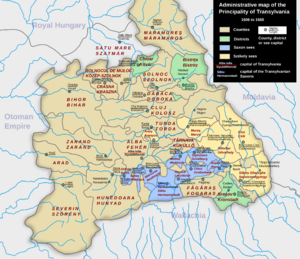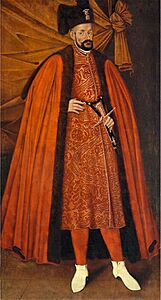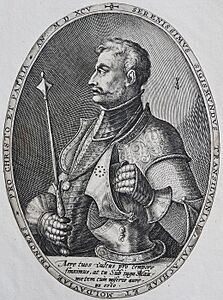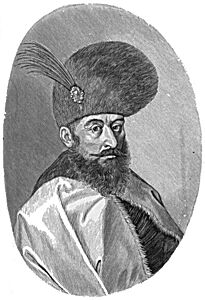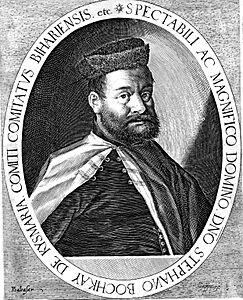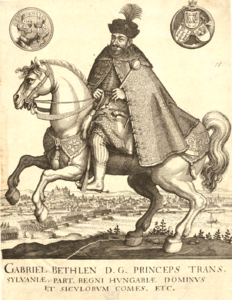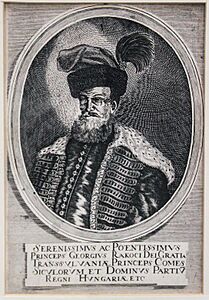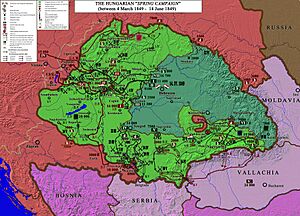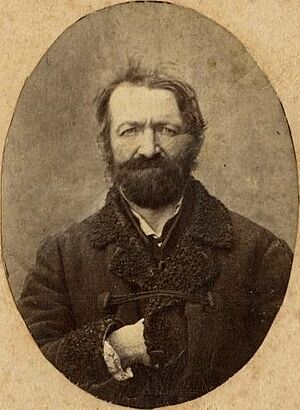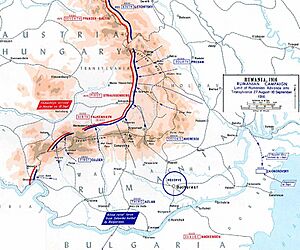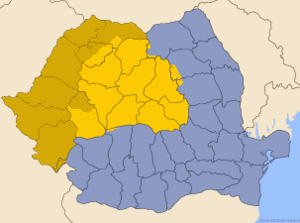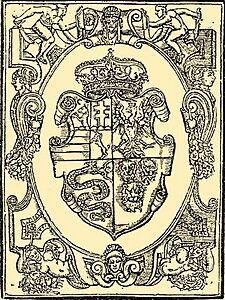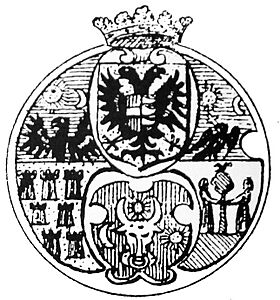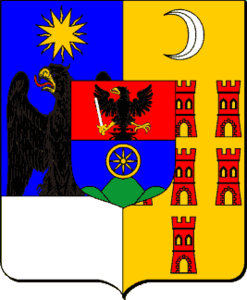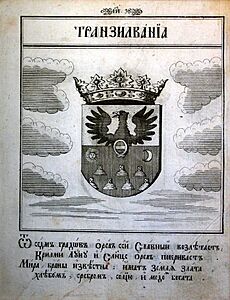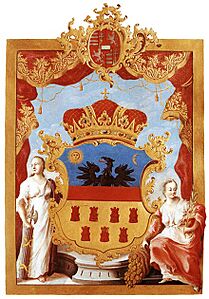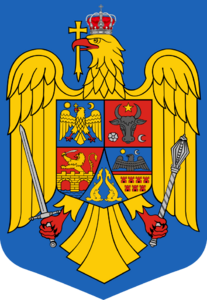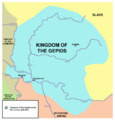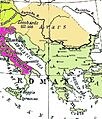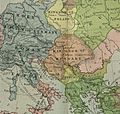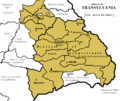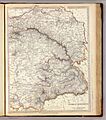History of Transylvania facts for kids
Transylvania is a historic region in central and northwestern Romania. It has a long and interesting past, shaped by many different groups of people over thousands of years. Imagine a land surrounded by forests and mountains – that's where the name "Transylvania" comes from! It means "land beyond the forest."
This region was once part of the ancient Dacian Kingdom, then the Roman Empire. Later, groups like the Goths, Huns, and Gepids moved through and settled here. In the 9th century, the First Bulgarian Empire had some control. Then, the Hungarians arrived and Transylvania became part of the Kingdom of Hungary in 1002. It stayed connected to Hungary for many centuries, until 1920.
After a big battle in 1526, Transylvania became a special state called the Principality of Transylvania. For a long time, it was like a smaller kingdom that had to pay tribute to the powerful Ottoman Empire. But it also had ties to the Habsburg rulers.
In the late 1600s, the Habsburgs took control. After a war for independence failed in 1711, Habsburg leaders replaced the Transylvanian princes. Later, in 1867, Transylvania became part of the large Austro-Hungarian Empire.
After World War I, in 1918, the Romanians in Transylvania decided to join Romania. This was made official by the Treaty of Trianon in 1920. In 1940, a part of Transylvania went back to Hungary for a short time during World War II, but it returned to Romania after the war ended.
Because of its long and varied history, Transylvania has a mix of cultures, languages, and religions. Today, most people are Romanian, but there are also many Hungarians (especially a group called Székelys) and a smaller number of Germans. All these groups have helped make Transylvania the unique place it is today!
Contents
What Transylvania Means
The name "Transylvania" comes from Medieval Latin words. It means "land beyond the forest." This name was first written down in 1075. The Hungarian name for the region is Erdély, which also means "beyond the forest." The Romanian name, Ardeal, comes from the Hungarian name. So, no matter the language, the name tells us about the forests that surround this historic land!
Ancient Times in Transylvania
Transylvania has been home to people for a very long time. We can learn about its ancient past from old writings and things found by archaeologists.
Early People and the Dacians
One of the first groups we know by name were the Agathyrsi. They lived in Transylvania around 500 BCE. Ancient writers said they loved gold ornaments. Later, they mixed with the Dacians.
The Dacians were a strong people who built a kingdom. Their most important king was Burebista, who lived around the time of Julius Caesar. Transylvania was the heart of the Dacian kingdom. The Dacians built many strong, fortified cities, like Sarmizegetusa Regia.
Dacians and the Roman Empire
The powerful Roman Empire wanted to expand its lands. This led to big wars between the Dacians and the Romans. The Dacian king Decebalus fought bravely against the Romans from 85 to 89 CE. The Romans even paid the Dacians a lot of money to keep the peace!
But the peace didn't last. In 101 CE, the Roman emperor Trajan started a major military campaign against the Dacians. He brought a huge army. The Romans won, and Decebalus became a king under Roman protection.
Another war happened in 105–106 CE. The Romans attacked Sarmizegetusa Regia, the Dacian capital, and burned it down. King Decebalus tried to escape but took his own life rather than be captured. The Romans found a huge treasure of gold and silver that Decebalus had hidden!
After these wars, parts of Dacia, including Transylvania, became a Roman province called Roman Dacia.
Roman Rule in Dacia
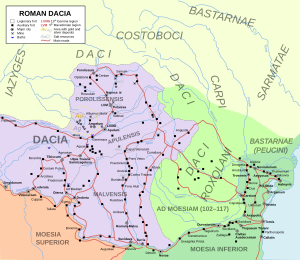
The Romans built many things in their new province. They set up military centers and forts, like at Apulum. They also built roads to connect cities and forts. A famous bridge, Trajan's Bridge, was built to help with the conquest.
The Romans also created new towns, like Ulpia Traiana Sarmizegetusa, which was named after the old Dacian capital. Many Roman settlers came to live in Dacia, including soldiers, miners, and traders. They built farms and houses in the Roman style.
Dacia was one of the last places the Roman Empire conquered, and one of the first they left. After less than 170 years, the Romans left Dacia in 271 CE. This was because of increasing pressure from other groups like the Visigoths. The Roman emperor Aurelian moved Roman citizens from Dacia to a new area south of the Danube River.
Historians still debate what happened to the Dacian people after the Romans left. Did they stay and mix with the Romans, becoming the ancestors of today's Romanians? Or did most of them leave or disappear? This is a big question in history!
New People Arrive: The Migration Period
After the Romans left, many different groups of people moved through Transylvania. This time is called the Migration Period.
Goths and Huns
The Goths settled in southern Transylvania in the late 300s. They were a Germanic tribe. But soon, a new powerful group arrived: the Huns.
The Huns were led by a famous warrior named Attila. In 376 CE, the Huns defeated the Visigoths and forced them to move. The Huns set up their main base in the Carpathian Basin, which includes Transylvania. Hunnic princes and lords even built summer homes in Transylvania.
Gepids, Avars, and Slavs
After Attila's death, the Hunnic Empire broke apart. The Gepids took control of Transylvania in 455 CE. They ruled for about two centuries.
Then, in 568 CE, the Avars established a large empire in the Carpathian Basin. They controlled the region for 250 years. The Slavs also settled in parts of Transylvania starting in the 600s.
In the early 800s, the Avars were defeated by the Franks and the Bulgars. Southern Transylvania then became part of the First Bulgarian Empire.
The Hungarians Arrive
The Hungarians arrived in the Carpathian Basin around 895 CE. They were led by Grand Prince Árpád. They slowly took control of the region. Some historians believe that some Hungarians were already living in the area before this main arrival.
Archaeological finds show early Hungarian settlements in Transylvania from the 900s. These include special horse burials, which were a tradition of the Huns and Hungarians.
A powerful Hungarian family, led by Gyula II, ruled Transylvania from around 925. His capital was Gyulafehérvár (now Alba Iulia in Romania). Gyula II even visited Constantinople and was baptized there, bringing a bishop back to Transylvania. His daughter, Sarolt, married Géza, the Grand Prince of the Hungarians. Their son, Vajk, became the first king of Hungary, King Stephen I, in 1000 CE.
Legends of the Hungarian Conquest
Old Hungarian stories, like the Gesta Hungarorum, tell about the enemies the Hungarians faced when they arrived. These stories mention leaders like Gelou, Glad, and Menumorut.
Gelou was described as a "Vlach" (an old name for Romanians) ruler in Transylvania. He was said to be defeated by a Hungarian leader named Töhötöm. Some historians think Gelou might be a made-up character, named after a village.
Glad was said to rule the Banat region. The story says he came from Bulgaria and had an army of Cumans, Bulgarians, and Vlachs. He was defeated by the Hungarians.
Menumorut was said to rule lands between the Mureș and Tisza rivers. The story says his land was home to Khazars and Székelys, and he was loyal to the Byzantine Emperor. He was also defeated by the Hungarians.
Historians debate whether these figures were real people or just characters in the stories. It's important to remember that these stories were written much later than the events they describe.
Transylvania in the Middle Ages
Transylvania became an important part of the Kingdom of Hungary during the Middle Ages.
Becoming Part of Hungary
King Stephen I of Hungary wanted to unite all Hungarian lands. In 1002, he led his army into Transylvania and took control. This brought Transylvania fully into the Kingdom of Hungary.
Transylvania was managed by a special leader called a voivod, who was chosen by the king. The first voivod was said to be Zoltán of Transylvania, a relative of King Stephen.
Protecting the Borders
Transylvania was often attacked by groups like the Pechenegs and Cumans. Hungarian kings, like King Ladislaus I, fought to protect the region. There are famous stories and frescoes (wall paintings) of King Ladislaus fighting these invaders.
Special Groups in Transylvania
Three main groups had special rights and power in medieval Transylvania:
- Hungarian Nobles: These were powerful landowners.
- Saxons: These were German colonists who settled in Transylvania in the 1100s and 1200s. They built many fortified towns, which is why the German name for Transylvania, Siebenbürgen, means "Seven Castles." They had their own special laws and paid taxes directly to the king.
- Székelys: This was a Hungarian ethnic group who lived in eastern Transylvania. They were known as fierce warriors and guarded the eastern borders of the kingdom. They also had special rights and their own leaders.
These three groups were sometimes called the "Three Nations" of Transylvania.
Mongol Invasions
In 1241, the Mongols invaded Transylvania, causing a lot of destruction. Many cities were destroyed, and many people died. The Mongols attacked again in 1285, but this time, the local people – Székelys, Romanians, and Saxons – fought back and blocked their paths.
Romanians in Medieval Transylvania
Old documents from the 1200s and 1300s mention Romanians (called "Vlachs") living in Transylvania. For example, a document from 1224 says that Saxons could use certain forests together with Vlachs and Pechenegs.
In 1291, King Andrew III of Hungary held a big meeting in Alba Iulia. Representatives of "all nobles, Saxons, Szeklers and Vlachs" attended. This shows that Romanians were an important group in Transylvania at that time.
Romanians often followed their own traditional laws, called "Vlach law." This law was common among shepherds and people living in mountainous areas. It allowed for some self-governance and different tax rules.
However, over time, the Romanians gradually lost their political rights. In 1437, Hungarian and Romanian peasants rebelled against their lords. To stop the revolt, the Hungarian nobles, Saxons, and Székelys formed an alliance called the Unio Trium Nationum (Union of the Three Nations). This union protected their privileges but excluded the Orthodox Romanians from political power. Many wealthy Romanians became Catholic and adopted Hungarian customs to keep their status.
Ottoman Threat and John Hunyadi
The Ottoman Empire became a big threat to Hungary and Transylvania in the 1400s. A very important leader during this time was John Hunyadi. He was a brilliant general who fought many battles against the Ottomans. He became the Voivode of Transylvania and later the Regent-Governor of Hungary.
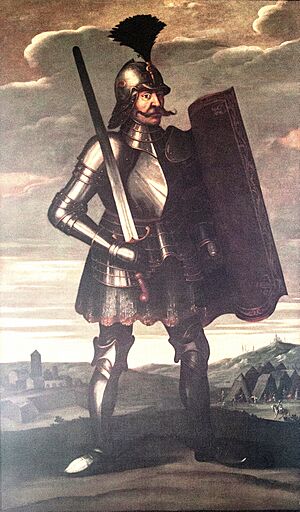
Hunyadi won several important victories, like the Battle of Hermannstadt in 1442. Another huge battle was the Battle of Breadfield in 1479, where the Hungarian army defeated a much larger Ottoman force. These victories protected Transylvania from Ottoman attacks for many years.
Transylvania in Early Modern Times
This period saw Transylvania become a special principality and then come under Habsburg rule.
The Principality of Transylvania
After the Hungarian king died in a battle against the Ottomans in 1526, Hungary was divided. A part of it became the Eastern Hungarian Kingdom, and from this, the Principality of Transylvania was formed in 1570.
This principality was semi-independent, but it had to pay tribute to the Ottoman Empire. It was a unique place because it allowed different religions to exist side-by-side. In 1568, the Edict of Torda declared freedom of religion for Catholics, Lutherans, Calvinists, and Unitarians. This was very unusual for Europe at the time, where religious wars were common. The Orthodox Church was also tolerated.
Transylvania was ruled by its own princes and a parliament called the Transylvanian Diet. This parliament included representatives from the Hungarian nobles, Saxon leaders, and Székelys.

One famous prince was Michael the Brave. In 1599, he took control of Transylvania. In 1600, he also gained control of Moldavia and Wallachia, briefly uniting the three main regions of modern Romania. However, his rule didn't last long, and he was assassinated in 1601.
Later, princes like Gabriel Bethlen and George I Rákóczi brought a "golden era" to Transylvania. They supported education and culture, and their capital, Alba Iulia, became a center for Protestantism. They also made sure that different religions were tolerated.
-
John Sigismund Zápolya, first Prince of Transylvania.
-
Stephen Báthory, Prince of Transylvania and King of Poland.
-
Sigismund Báthory, a prince of Transylvania.
-
Michael the Brave, a prince who united three regions.
-
Stephen Bocskai, Prince of Transylvania.
-
Gabriel Bethlen, a prince during Transylvania's "golden era."
Habsburg Control
After defeating the Ottomans in 1683, the Habsburgs (rulers of Austria) began to take control of Transylvania. They wanted to strengthen their rule and promote the Roman Catholic Church. They also tried to get Orthodox priests to join the Greek-Catholic Church, which was similar to Catholicism but kept Orthodox traditions.
From 1711, Habsburg governors ruled Transylvania. In 1765, it was officially called the Grand Principality of Transylvania, confirming its special status within the Habsburg Empire.
In 1784, a big peasant revolt led by Romanian leaders like Horea, Cloșca, and Crișan broke out. They wanted an end to serfdom (where peasants were tied to the land) and equal rights for Romanians. The revolt was put down, and its leaders were executed.
In 1791, Romanians asked the Emperor for religious equality and to be recognized as a fourth "nation" in Transylvania. But the Transylvanian parliament rejected their requests.
Transylvania in Modern Times
The 1800s and 1900s brought big changes to Transylvania, including revolutions and new borders.
The Revolutions of 1848
In 1848, revolutions swept across Europe. In Hungary, leaders wanted reforms and for Transylvania to unite with Hungary. At first, Romanians in Transylvania hoped these changes would help them. But Hungarian leaders didn't fully recognize Romanian rights.
Romanians held their own meetings, calling for equal representation and an end to oppression. The Saxons also worried about losing their old privileges if Transylvania united with Hungary.
War broke out in Transylvania. Austrian troops, along with Romanian and Saxon fighters, battled against the Hungarians. A Polish general, Józef Bem, led the Hungarians and pushed the Austrians out. But then, the Russian Tsar sent troops to help Austria, and Bem's army was defeated.
A Romanian leader named Avram Iancu led a guerrilla fight in the mountains against the Hungarian forces. He managed to hold out for months. Eventually, the Hungarian revolution was defeated.
After the revolution, Austria ruled Transylvania directly. They gave land to former serfs, but it was often not enough. Romanians were still not fully equal.
The Austro-Hungarian Empire
In 1867, the Austro-Hungarian Compromise created the Austro-Hungarian Empire. This meant Austria and Hungary were two separate kingdoms under one ruler. As a result, Transylvania's special status ended, and it became a province under the Hungarian parliament.
During this time, the Hungarian government tried to make everyone speak Hungarian and adopt Hungarian culture. This was called "Magyarization." Romanians and German Saxons in Transylvania were affected by this policy.
World War I and Unification with Romania
When World War I started in 1914, Romania stayed neutral at first. But in 1916, Romania signed a secret treaty with the Allied Powers (like Britain, France, and Russia). The Allies agreed that Transylvania would become part of Romania after the war if Romania joined them. So, Romania declared war and its army entered Transylvania.
The war was tough for Romania, and it was forced to sign a peace treaty with Germany in 1918. But by then, the Austro-Hungarian Empire was falling apart.
In 1918, after Germany lost the war, the Austro-Hungarian Empire collapsed. The leaders of Transylvania's Romanian National Party met and declared that Transylvania would unite with Romania. On December 1, 1918, a huge assembly in Alba Iulia, called the Great National Assembly of Alba Iulia, officially called for the unification of all Romanians into one state.
The Romanian Army entered Transylvania. In 1920, the Treaty of Trianon officially set the new borders, giving Transylvania and other regions to the Kingdom of Romania. This created "Greater Romania," a larger state that included most historical Romanian lands.
Transylvania Today
Transylvania has continued to change in recent times.
World War II and the Communist Era
In August 1940, during World War II, the northern part of Transylvania was given back to Hungary by an agreement called the Second Vienna Award. But after the war, in 1947, the Treaty of Paris confirmed that Northern Transylvania would return to Romania.
From 1947 to 1989, Romania, including Transylvania, was under a communist government. In 1952, a special area called the Magyar Autonomous Region was created in Transylvania for the Székely Hungarians. This region had Hungarian as an official language. However, in 1968, this region was removed, and the country went back to a system of counties.
In December 1989, protests started in Timișoara, a city in Transylvania, partly because of issues faced by the Hungarian minority. These protests quickly grew into a revolution across Romania, leading to the fall of the communist government.
Transylvania Now
Today, Transylvania is a vibrant part of Romania. It includes several Romanian counties. The region is known for its beautiful landscapes, historic cities, and diverse culture. While there are still discussions among historians about the past, Transylvania continues to be a place where different traditions and languages live side-by-side.
Coat of Arms of Transylvania
The coat of arms of Transylvania has special symbols that represent its history and people. It was officially created in 1659.
It shows:
- A black eagle on a blue background, representing the Hungarians.
- The Sun and the Moon, representing the Székelys.
- Seven red towers on a yellow background, representing the seven fortified cities built by the Saxons.
This coat of arms was granted by Queen Maria Theresa in 1765. Today, while it's not an official flag, the Transylvanian coat of arms is part of the national Coat of arms of Romania. It was also part of the Coat of arms of Hungary for a long time.
-
Coat of arms of John Sigismund Zápolya.
-
Coat of arms of Sigismund Báthory.
-
Seal of Michael the Brave.
Images for kids
-
Kingdom of the Gepids in the 6th century (539–551)
-
The Avar Khaganate around 582–612
-
King Saint Stephen of Hungary captures his uncle Gyula, the ruler of Transylvania (Chronicon Pictum, 1358)
-
King Saint Stephen of Hungary defeats Kean "Duke of the Bulgarians and Slavs" (Chronicon Pictum, 1358)
-
After the Battle of Kerlés in 1068, Saint Ladislaus is fighting a duel with a cuman warrior who kidnapped a girl (Chronicon Pictum, 1358)
-
Kingdom of Hungary in 1190, during the rule of Béla III
-
Battle of Breadfield (Colorized lithography from Eduard Gurk after Ion Osolsobie, 19th century)
-
Transylvania as part of the Eastern Hungarian Kingdom. "Universitas Siculorum" are the setas of the Székelys and "Universitas Saxorum" are the seats of the Transylvanian Saxons.
-
Gabriel Báthory, Prince of Transylvania (1608–1613)
-
George II Rákóczi, Prince of Transylvania (1648–1657)
-
Romania in 1940 with Northern Transylvania highlighted in yellow
-
The Red Map. Ethnic map of the Hungary proper publicized by the Hungarian delegation. Regions with population density below 20 persons/km2 are left blank and the corresponding population is represented in the nearest region with population density above that limit. The vibrant, dominant red color was deliberately chosen to mark Hungarians while the light purple color of the Romanians, who were already the majority in the whole of Transylvania back then, is shadow-like.
See also
 In Spanish: Historia de Transilvania para niños
In Spanish: Historia de Transilvania para niños
- Prehistory of Transylvania
- History of Romania
- History of Hungary
- List of Transylvanian rulers
- History of the Székely people
- Austria-Hungary
- Dacia
- Origin of the Romanians
- Avram Iancu




